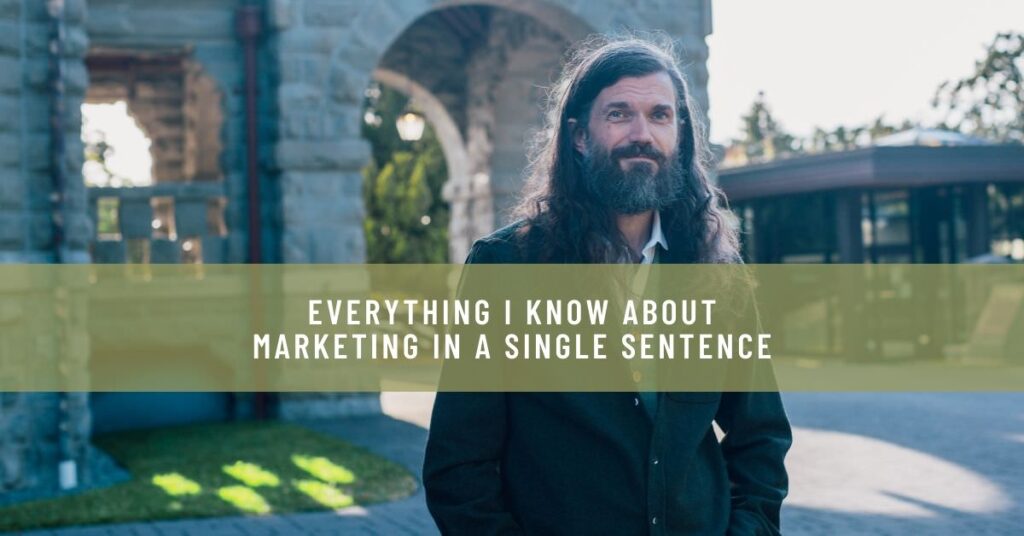Before someone buys from you, everything in the following sentence needs to be true (and true in the order it appears in this sentence):
There’s a result clients crave that they believe can be attained, and they believe you can help them attain it better than others.
So simple.
Of course.
But we often miss pieces of this in our marketing.
I could even distill that sentence down into three words: relevance, credibility, value.
All too often, we don’t identify and directly name the problem we’re solving (or result we’re offering) and so people don’t see the relevance in what we’re offering.
We ignore the fact that they may be in a state of learned helplessness about solving their problem. They might not believe it’s possible for it to be solved at all. Period.
They might have gotten comfortable and feel like solving this problem is a could but not a must.
They might believe that it can be solve but not trust that we can solve it.
They might trust that we can solve it but not be convinced that we’re the best option for them.
If you’re trying to market to someone to convince them that you’re the very best there is at solving a problem they don’t believe is solvable, you will get nowhere.
Obviously, our ideal clients, the bullseyes, are those for whom that whole sentence is true. But that’s a very small number of people indeed.
And so, we market. And so, we educate. And so, we build relationships. Sometimes fruit takes a while to ripen.
Danny Iny does brilliant work in this in helping his clients create what he calls a ‘Demand Narrative’ for their launches.
His premise is, if people believe that solving their problem or achieving a certain result is impossible, then the first stage of your marketing must focus on making the case for them that it is, indeed, possible for it to be solved.
Below are five questions that can help you think this through…
Q1: What is possible for them they didn’t think was possible for them before?
Remember: it’s not the first time in their life they’ve thought about this result.
They’ve likely daydreamed about it for years and reality has ground them down. They’ve tried to make it happen and failed. Now they’re resigned. They believe that this isn’t possible to achieve or, at least not for them.
The more specific the result is that you’re offering, the stronger the response will be.
Q2: What evidence can you offer that this is possible?
Case studies and stories are a fine way to do this. Show them how people just like them have achieved what they are hoping to achieve.
Verge Permaculture did a brilliant job of this when they created ten short films about their grads. They knew that many of the people attending their Permaculture Design Certifications wanted to make a living with permaculture. So, instead of just writing a sales letter telling them that this was possible, they showed them. “Here are ten of our grads and how they’re making a living with permaculture.” Brilliant.
Another way to do this is to share a clear and compelling point of view about your approach to the problem. This perspective needs to be fresh. It can’t be what they’ve tried before. You need to point to a new mechanism, technology or process that you use when approaching this issue. You’ve got to make the case that you have a trustworthy take on this and some track record in helping people achieve this result.
You’ve got to make the case, if it’s true, that your approach to the issue is new. There is often the possibility of saying something like, “It’s understandable that you never achieved ________ (result) because you never tried/were missing _______.”
Before you sell them on hiring you, sometimes you need to convince them that the approach you use is valid.
Before you try to convince them to get a ticket on your boat, you might need to convince them that boats are the way to go (vs. swimming, airplanes, submarines and, of course, dirigibles).
In the 1980’s, before they could market Apple products, they had to market the idea that you could have a computer on your desk.
In the 1990’s, before they could market Palm Pilots, they had market the idea of a Personal Digital Assistant.
Often you’ve got to market the category before you market the brand.
Before you sell them on getting acupuncture with them, you may need to sell them on Traditional Chinese Medicine as a whole.
Before I convince someone to buy my book on niching, I will often need to convince them that figuring out their niche in the missing link in their marketing.
Before you sell them on your offers, you may have to sell them on the type of work you do, your modality as the transformative approach they’ve been looking for.
Q3: What are the main reasons people give for this result being out of reach for them?
Of course, once people see what’s possible, they will get excited and… then all of the reasons why it might work for others but not for them are likely to appear. It’s predictable.
They’re like to say something like the following to themselves, “Okay, this is possible in general but I don’t think it will work for me specifically because ________.”
And you need to know what these objections are. You need to know what they would put in this blank. And you need to address these candidly and directly.
You need to be able to let them know which of those concerns are real deal-breakers and where they aren’t. Sometimes, they will be right in their assessment. Sometimes, given the limitations of their lives, it isn’t possible for them. And sometimes they are wrong.
Q4: Which of those reasons do you agree with and which ones do you not?
This comes down to sharing your point of view. Your take on things.
Q5: How could they achieve their goals even if ______ factors are present/absent?
Once they are open to the possibility that this result might be possible for them, it can be a good idea to really paint the picture for them of what it could mean to their life if they had it. Tell them the story of what might be different. Do your best to put them in the experience. This might already have been achieved by your stories and case studies. But you can also say something like,
“Imagine it… it’s five years from now and you have this result…” and put them in the experience.
My caveat here: do not over-promise. If that possible future for them isn’t compelling enough without your exaggerating then it’s not worth selling.
When you’re launching something, a basic approach is to simply email your list about it (and I’ve done that plenty).
But the only people who will sign up are those who are those where…
There’s a result they crave that they believe can be attained and they believe that you can help them attain it better than others.
So, a savvier approach can be to create layers of your marketing. Danny calls this Behaviour Based Segmentation.
- Layer One: Prove that it’s possible. If they engage with that content (e.g. open those emails, watch those videos to the end, download those eBooks etc.) then you move them to…
- Layer Two: Help them understand if it is possible for them. Caveat: Do not over-promise here. Be clear for whom this is a fit for and for whom it isn’t. If they engage with that content, then you move them to…
- Layer Three: Help them understand your unique approach to solving the issue and seeing if it’s a fit for them. And, at this point, you can make the offer. They don’t even see your offers in those first two layers. Why would you bother showing someone an offer for whom it wasn’t a fit?
And, of course, this means a lot more planning than most of us do and more tech savvy than most of us might have at the moment (though it’s all learnable).
It means a certain amount of savvy in how to keep track of where they are in their process around grappling with this issue and inviting them to take the next step if it’s a fit.
And, if they go to a video and don’t watch the whole thing? You could send them a reminder to come back and finish it.
The big question is this: Where are they not yet convinced? And is there a case to be made? If not, you can bless and release them. You continue to meet them where they’re at making the case for the things you believe to be true. You never make an offer to them that they haven’t indicated they are ready to receive.
If they’re not interested in the result? They don’t hear from you again about it.
If they haven’t indicated that they believe it can be attained? You never mention the product until they indicate they are open to the possibility that it might be possible.
If they don’t believe you can help them? You focus on building that trust, not pushing your product.
There’s a lot of thought we can put into marketing. But, rather than getting overwhelmed, try this: pick your flagship product or service (just one) and run it through these five questions. See what you come up with and take an hour to consider how that might help shape the way you structure your marketing in the future.




